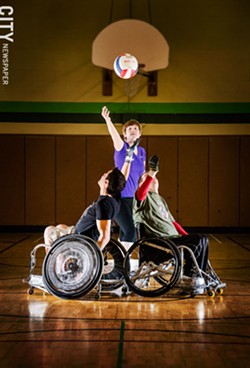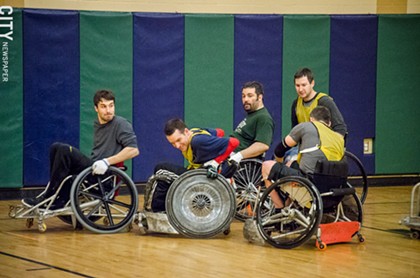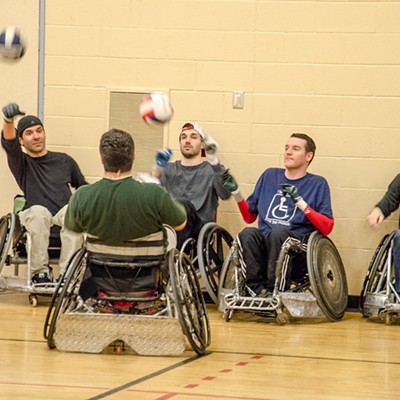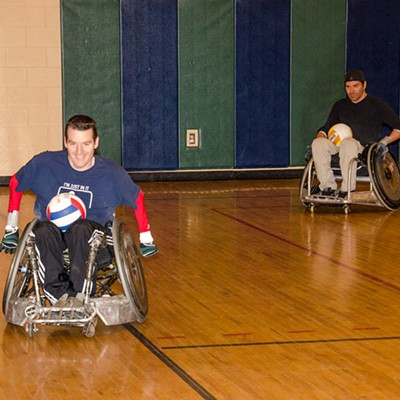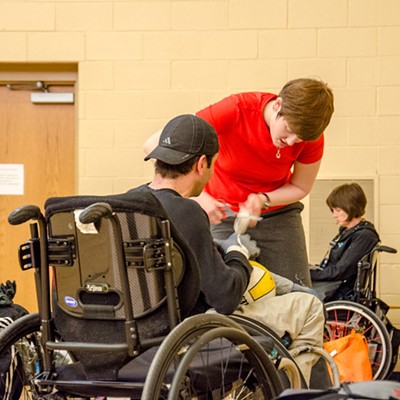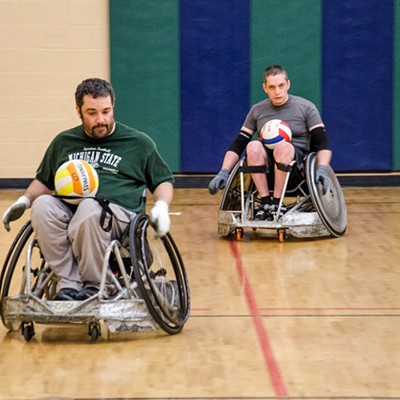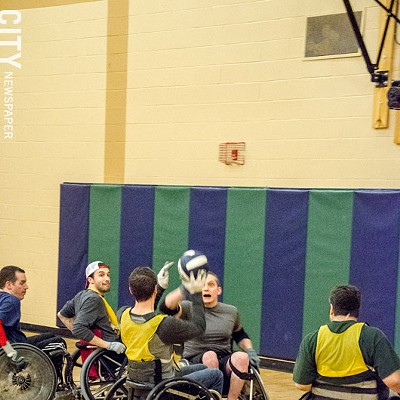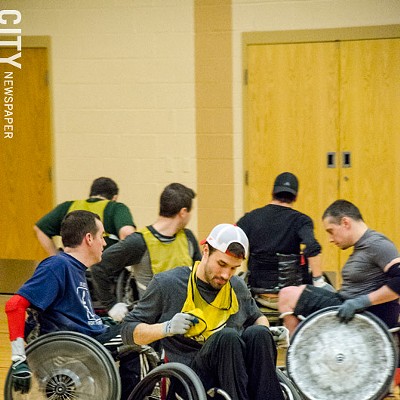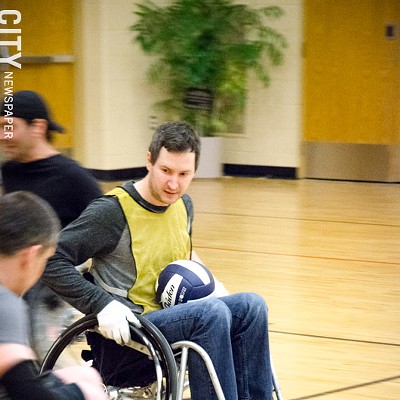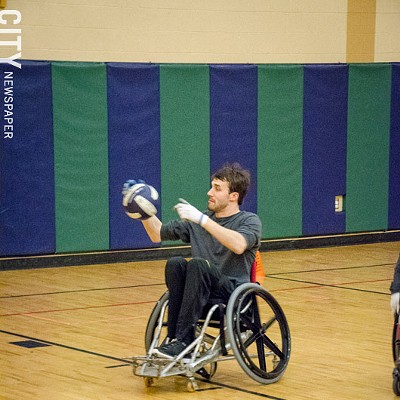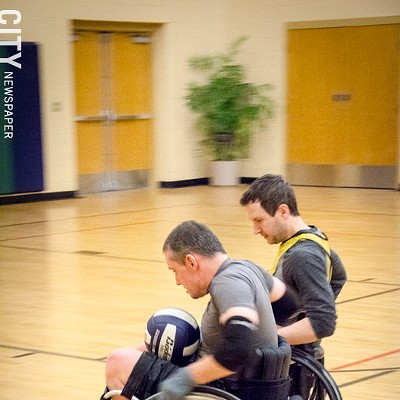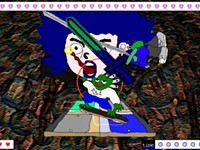
Since August 2013, the Wreckers have gained over a dozen members, including Mike Bliss, Chris Hilderbrant, Jerremy Lorch, Dave King, and Craig Mills (back to camera).
[
{
"name": "500x250 Ad",
"insertPoint": "5",
"component": "15667920",
"parentWrapperClass": "",
"requiredCountToDisplay": "1"
}
]
In one swift motion, Jerremy Lorch snatches a volleyball out of the air, plops it on his lap and whizzes off down the basketball court — a strong breeze following his wheelchair as he speeds down the sideline. But Lorch doesn't get far. Another man in a wheelchair rams into him with spectacular force, nearly toppling both players to the ground. The ball pops loose — and it's a free-for-all.
The athletes huff as they hustle their chairs toward the ball. It's a frantic dash. Arms are nearly knotted until a man finally grabs the ball and hurls it across the court.
Chris Hilderbrant reaches for it, the tips of his fingers just able to knock it down, but he doesn't have a chance. Another chair rams him, knocking Hilderbrant to the floor. Now on his side, his shirt is suddenly readable: "If you can read this, tip me back up!"
Someone from the sidelines rushes onto the court and pops Hilderbrant back upright on his wheels.
"Nice hit, Craig!" Hilderbrant shouts. "But you better watch your back now!"
Craig Mills rolls over, pats Hilderbrant on the back with a knowing grin, and tosses the ball into his lap.
This cacophony of grunts and clashing metal-on-metal echo off the walls of the Pieters Family Life Center's gym several times a month as the Western New York Wreckers get into competition shape.
The Western New York Wreckers is a relatively new wheelchair rugby team in the area. With about a dozen players from the Buffalo and Rochester area, the team is looking to gain momentum and players in order to compete with athletes across the country.
In August 2013, Jerremy Lorch and Chris Hilderbrant connected with Luther Vucic of Buffalo. The three had a mutual interest in creating a wheelchair rugby team, but there weren't enough players from either city to form a full team, so they combined forces. The team has since recruited about 10 more regular players and a handful who practice with the team sporadically.
"We're amateurs," Lorch says modestly — the WNY Wreckers is technically a professional team under the US Quad Rugby Association.
"There aren't a whole lot of levels in quad rugby," Lorch adds, but it's evident the players are passionate about their sport and are growing in skills practice by practice.
Wheelchair rugby was developed in Canada in the late 1970's by a group of quadriplegic athletes who were looking for an alternative to wheelchair basketball. A popular sport among paraplegics, wheelchair basketball requires a wider range of arm and hand functions that can be troublesome for some quadriplegic athletes.
The International Wheelchair Rugby Federation formed in 1993 and has since governed the sport. Wheelchair rugby — or quad rugby as it is officially known in the U.S. — is often branded as the only full-contact wheelchair sport in the world and is now played in 26 countries, becoming a Paralympic summer sport in 2000.
The sport combines elements of rugby, basketball, and handball, with players competing in teams of four to pass and carry a volleyball-sized ball across the opposing team's goal line. Every 10 seconds, players must either pass or dribble the ball. The team has 40 seconds total to get the ball across the court — usually a regulation basketball court — to score points or it's a turnover.
"It's a pretty high scoring game because of the quick turnover in play," Lorch says.
Contact between wheelchairs is not only permitted, it's a key part of the game, as players maneuver and crash into one another to block and hold opponents. Wheelchair rugby was initially called 'Murderball' because of its hard-hitting nature.
"It's really almost just, 'Kill the carrier,'" Lorch says. "Hitting is an essential part of the game. At times, your role is not even to handle the ball, it's just to hit people."
At a recent practice, no sooner has Dave Sprout gotten his hands on the volleyball, he shouts "Kat, go deep!" to a woman halfway down the court. He hurls the ball. As it arcs gracefully in the air, the rest of the players haul down court to catch up. Just as it lands in Kat's hands — SMASH!
Craig Mills, who was guarding Kat to begin with, slams into her chair. Pretty soon there's an eight-chair pileup near the end zone, as players try to maneuver their chairs through tight spaces to get the optimal position to score.
Despite all the hitting, the Wreckers haven't had any major injuries since they started practicing. So far, the worst injuries have been bruises and sore arms when the players head home after a long practice. "We had a few pinched fingers in the beginning," Lorch says. "But that's because we were using our everyday chairs and the wheels were right up against one another up top."
Part of what got Lorch interested in starting a team was the aggressive nature of the game, combined with the camaraderie and understanding of his fellow players. Lorch was paralyzed in a diving accident four years ago while out on a friend's boat. He thought he was in deep water — and while one end of the boat was, the other was hovering just above a sandbar, which he dove into headfirst.
"I swam in high school, so I should have known better than to dive that way," Lorch says.
After more than a year in the hospital and painful physical therapy, Lorch was looking for something to do to stay active.
Most popular sports have been adapted for the handicap community, including basketball, hockey (played on specialized ice sleds), football, fencing and cycling (hand-cycling). For Lorch, it was initially wheelchair basketball. "Everybody starts out playing wheelchair basketball, it's a good gateway to other wheelchair sports," Lorch says. "I liked watching basketball, but it held no appeal to me whatsoever to play it."
Chris Hilderbrant, one of the other founding members of the Wreckers, felt the same way. He too had been in a diving accident.
"I wanted to find some sort of sport for myself, and most of the sports I like tend to be more 'hitting' sports; I like hockey, I like football. I was never a big basketball fan," he says.
Quad rugby gained popularity and prominence following the 2005 Oscar-nominated documentary "Murderball," which focused on the rivalry between the U.S. and Canadian teams leading up to the 2004 Paralympics games in Athens, Greece. The film was noted for scene after scene of wheelchairs zooming across courts and flipping over — in a spectacular ballet of metal-on-metal carnage. Even more notable, every player had a grin from ear to ear as they were flipped upright again on the court — before speeding off after their next opponent.
The joy can be seen in the Wreckers' practices — even when the players are taking hard hits. After a goal for the other scrimmage team, Dave Sprout tosses the ball to his teammate, Kat. She isn't handicapped, but helps the team practice. She's not as comfortable in the chair, and is quickly rammed by Craig Mills, who has raced from the opposite side of the court in one blink. Kat laughs, shrugs off the hit and tosses the ball to Sprout, who's wheeled himself halfway down the court.
"I think that in terms of hitting and aggressiveness, there's typically very little of that in the disability community," Hilderbrant says. "And people who can play quad rugby can't necessarily play other disability sports, so it's really giving them an outlet to find their competitiveness."
"I definitely think the hitting appeals to a lot of people — I know it does to us. Good way to get some aggression out," Lorch adds.
Wheelchair rugby athletes go through a series of tests given by International Wheelchair Rugby Federation-approved testers to determine the strength, flexibility, sensation and tone in their arms, legs, and trunk (upper body). These factors play into the players' classification score, which range from 0.5 to 3.5. At any given time, teams are not allowed to have a collective classification value higher than 8.
Assessors also watch the athlete's execution of ball and wheelchair handling on court to make a final determination of the athlete's class.
Hilderbrant recently underwent training for the team, allowing him to assign classification scores. Most players have spinal cord injuries with full or partial paralysis of the legs and partial paralysis of the arms, while others have diseases like cerebral palsy, muscular dystrophy or other medical conditions that have left them partially paralyzed.
"Diving accidents seems to be the popular way to get on the team," Lorch jokes.
That's the reason the team's coach, Brian Weber, is also in a wheelchair. Weber was paralyzed from the neck down after a swimming accident on Lake Ontario. While he can't play with the team because he uses a motorized wheelchair — that's against the rules — he knows a thing or two about coaching. Weber coaches the Gates-Chili High School football team.
Just like any sport, warm ups are key. From stretching to throwing drills to "suicide sprints" back and forth across the gym, the Wreckers are pushing as hard as they can — striving to get better at the game they've fallen in love with.
"Make sure you're focused on your target," Sprout says to Hilderbrant during drills. Hilderbrant is in the hot seat, facing six teammates lined up against the wall. With three balls in play, Hilderbrant is throwing to his teammates, one at a time. At the same time, they're hurling them right back at him.
"We're not what most people think of when you hear 'quadriplegic,'" Lorch says, adding that many people immediately think of Christopher Reeve. The team defies any preconceptions – whizzing up and down the court with ease, turning with air-tight precision and sending the ball soaring with strength and style.
"There's definitely a stereotype that comes with that word that, 'Oh, you're fragile,' but that's not the case. If we were fragile, we wouldn't have gotten ourselves into these situations."
At one of the team's first practices in new chairs, Hilderbrant hit Lorch hard — causing the back of the chair to snap.
"Hitting is pretty much what it's all about," Lorch says. "It actually has very little to do with regular rugby. I think they chose the name simply because of the hitting and the roughness of the game."
Players must use manual wheelchairs, which have several key modifications, including a front bumper to help with hits; wings, which are positioned in front of the main wheels to make it more difficult to hold opponents; spoke protectors to prevent damage to the wheels; and an anti-tip guard on the back. The wheels are slanted inward toward the player, so hands are less likely to get caught on another chair during game play, and players have more mobility and agility in the chair. The seat also dips down a bit in the back, almost like a bucket seat in a sports car.
"The hits look pretty intense, and they are, but the balance is so much better on these [chairs]," Hilderbrant says. "You're lower to the ground, the wheels are hammered in. You're like a little cannonball."
The Wreckers' current game chairs were donated from a team that had already used them for several seasons. While they're worn, they work much better than everyday chairs.
"We're very grateful to have these chairs, but they don't really fit us particularly well, so we're always trying to figure out which chair best fits who and what pieces we can put together to make a whole chair," Lorch says. The Wreckers held a fundraiser on Monday, April 21, to raise money for new chairs, which run about $5,000 apiece. If you missed it, the team accepts check, cash or PayPal donations. Visit Wnywreckers.com for more info.
The team is slowly gathering "groupies," many of whom are friends, family, or just fans of wheelchair rugby who help the team out with flat tires or when players flip over in their chairs.
"They're kind of like our own personal pit crew, like in NASCAR. You roll onto the sidelines, get a new tire and roll right back onto the court," Lorch says.
Unlike most sports, wheelchair rugby is pretty much a year-round sport, without a real season. There are about 20-30 teams across the U.S. and parts of Canada, many of which will host regional tournaments throughout the year and invite several teams to play.
The WNY Wreckers currently practice most Saturdays and some Mondays and is looking to up its practice schedule to twice a week.
Even though quad rugby is a specialized sport, the team is welcoming. "We're always looking for new people, even those who just want to try it out."
The team plans to start traveling to play games against other teams in the league this spring and summer. "We'll probably be destroyed the first few games," Hilderbrant says.
"He's wheeling circles around you, you can't let him!" Sprout shouts across the practice. He wheels over to show a teammate a maneuver. With a swift flick of the wrist, Sprout spins his right wheel backward and his left wheel forward, spinning the chair 360 degrees so fast it could seemingly cause whiplash.
"I think most people who see it are a little freaked out at first, like 'Oh my God, that looks scary,'" Lorch says. "But I think people pretty quickly realize 'Oh, this is pretty cool.'"
